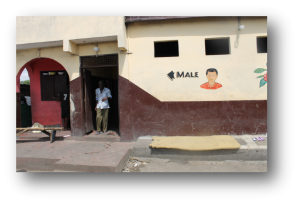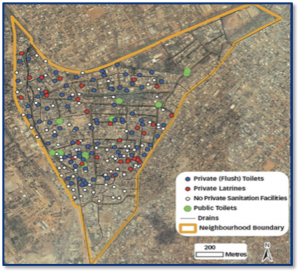Policy Note: Should Public Toilets Be Part of Urban Sanitation Solutions for Poor Families Living in Slums?
Background
Shared sanitation in urban areas is commonplace in Ghana. Approximately 73% of the urban population relies on shared sanitation facilities, the highest of any urban area in the world.(1) Pay-per-use public toilets are a particular type of shared sanitation facility, and, in Ghana, these typically cost between 15 to 30 pesewas per use (US $0.08–0.15).(2) In 2006, it was found that 41% of households in Accra, Ghana rely on public toilets.(3) Due to the cramped nature of Accra’s urban communities, construction of private toilets is often neither spatially nor financially feasible. However, public toilets do not meet the World Health Organization (WHO) and UNICEF’s Joint Monitoring Programme (JMP) for Water Supply and Sanitation’s definition of “safely managed” sanitation. This can create a disincentive to use public finances to build and safely manage public toilets even though they may be the only viable option in the short and medium term.(4) Poor sanitation costs Ghanaians up to

Figure 1: Man exiting public toilet in Accra, Ghana
US $12 per person each year.(5) About one fourth of deaths of children under five in Ghana are related to diarrhea.(6) The country has also experienced regular cholera outbreaks for the past several years.(6)
While Government of Ghana regulations require that all landlords provide household sanitation, this has been difficult to enforce and local governments have largely ignored the quality and hygienic status of public toilets.
This policy note draws on findings from Emory University’s Center for Global Safe Water, Sanitation, and Hygiene’s (CGSW) study Public Toilets and their customers in low-income Accra, Ghana and the related study on public health risks due to poor urban sanitation using the SaniPath Tool.2 The SaniPath Tool measures exposure to fecal contamination (i.e. E. coli) in low-income, urban communities.
Research Approach
A study was carried out on public toilets over six months in 2012 in four low-income neighborhoods (Alajo, Bukom, Old Fadama, Shiabu) in Accra using a mix of qualitative and quantitative methods. Data were collected on the physical conditions of public toilets, the population’s usage rates of toilets, the socio-demographic characteristics of customers, as well as customers’ views on the toilets. Surveys were administered to 800 households and included questions about hygiene practices and access to water and sanitation facilities. Customers were also interviewed regarding their frequency of use of the toilets and the prospective chances of acquiring their own household toilet. Additionally, focus groups were conducted to understand participants’ perceptions of the toilets, including the toilets’ accessibility and general sanitation options available within their community.(2)

Figure 2: Household survey locations and types of sanitation facilities in Alajo (Adapted from Peprah, D. et al. 2015)
Building on the public toilet study, the SaniPath Tool was used to assess potential public health risks as a result of poor access to urban sanitation facilities and unsafely managed fecal sludge. The goal of the SaniPath Tool is to address the scarcity of data available to sanitation decision makers and implementers in low-income urban communities and to provide evidence of public health risks associated with poor sanitation and fecal sludge management (FSM). The SaniPath Tool identifies and describes the sources and magnitude of fecal contamination in the public domain (using E. coli as an indicator organism), as well as characterizes the behaviors of adults and children that lead to exposure to fecal contamination. Through an exposure assessment model, SaniPath estimates which pathways pose the greatest risk of exposure to fecal contamination. The results of this assessment can be used to characterize a neighborhood according to a matrix of fecal exposure pathways. The outputs serve as a simplified, but informative, means of identifying priorities for sanitation investments and policy from a public health perspective. Accra was the first deployment of the SaniPath Tool. The study occurred from October to December 2013 in the same neighborhoods as the public toilet study.
Results
Results from the public toilet study found that adults over the age of 18 were most likely to use the public toilets. A public toilet was the usual place of defecation for 94% of respondents (half male, half female). Most of the toilet facilities observed in the study had visible feces and almost all had flies. Figure 2 maps the number of toilets in the neighborhood of Alajo and serves as an example for mapping done in all neighborhoods. These maps help visualize the lack of accessible facilities in these neighborhoods. Amongst all study neighborhoods, there were only a few hand washing stations observed and 38% had a bathing facility. Of those surveyed, 78% did not foresee owning their own toilet in the next year. Additionally, 40% of respondents cited open defecation as the alternative if public toilets were not available, and this practice was most common amongst children, the elderly, and those who did not wish to pay for the toilets. Toilet operators were blamed for the unclean state of their toilets. Space was cited as a major hindrance to building private toilets, and there was high demand amongst community members for an adequate quality and quantity of public toilets. The cost of public toilets (pay-per-use) was described as the most important reason for open defecation.

Figure 3: Characteristics of public toilet customers (Adapted from Peprah, D. et al. 2015)
Public toilets were reported to cost between 10 and 30 pesewas/use across all neighborhoods. This cost was generally considered burdensome. Lack of cleanliness was also an important factor deterring the use of public facilities.(2) Other survey responses can be found in Figure 3.

Figure 4: 82% of adults in Accra exposed to medium levels of fecal contamination from public toilets
The results from the SaniPath Tool in the four neighborhoods showed the highest concentrations of fecal contamination in open drains, soil, produce, and public toilets. Figure 3 is an example of the results collected from swabbing public toilets in Accra. The “risk profiles” show the percent of the population exposed to fecal contamination per month and the average dose of exposure (amount of E.coli ingested per month) through various pathways in the Shiabu neighborhood of Accra. Figure 4 shows the proportion of the adult population exposed to fecal contamination at public toilets in a month (82% of adults).** The people plots show red people for those exposed to fecal contamination and gray for the unexposed; the darker the red, the higher dose of exposure. The scale to the right of the risk profile has a black line to show where the dose falls on a scale from 100 (low exposure) to 1010 (high exposure) . In the example in Figure 3 of adult contact with public latrines, we see that there is a medium exposure.
Discussion and Recommendations
The two studies combined paint a bleak picture of sanitation and related public health risks for the urban poor living in the slums of Accra. Access to safely managed household sanitation facilities is very low and significant constraints exist for increasing access to household level sanitation including lack of space due to high density informal urbanization, high rates of rental units, unrespon—ive landlords, and capital construction costs that are not affordable to many poor families living in these slums. The alternative that exists and that is used by a large majority of adults living in the Accra slums is pay-per-use public toilets. These public toilets are generally poorly cleaned and maintained and using public toilets creates a public health risk for users.
Although households would prefer to have private facilities, conditions suggest that shared public toilets will, for the foreseeable future, continue to be the main available option for defecation in the slums of Accra. In this context, efforts are needed to improve existing and new public toilets to make them hygienic and safely managed in order to provide sanitation services that result in public health benefits.
Government support is crucial to the success of the proposed improvements. The government of Ghana is committed to reaching the WASH Sustainable Development Goals (SDGs) that call for the elimination of open defecation, safe sanitation for all, and the reduction of inequality in access to sanitation. However, the criteria established by the WHO/UNICEF Joint Monitoring Program (JMP) for the WASH SDGs does not consider shared toilets as meeting the criteria for safely managed sanitation. Since public toilets do not meet the JMP criteria for an improved toilet, they also do not meet current government of Ghana standards. This in turn creates a disincentive for local governments to invest in public toilets and related safe management of the fecal sludge as part of their urban sanitation services.
The findings reported in this policy note lead to the recommendation that in order to protect the public health of families living in urban slums, the government of Ghana should reform their current policies regarding public toilets in urban slums despite not being recognized by the WHO/UNICEF JMP. Reforms to consider include formal recognition of public toilets as viable sanitation solutions, exploring possible partnerships with the private sector to finance, operate and maintain public toilets, development of regulations and standards for public toilets, and effective monitoring of compliance. In addition, the government should review financing approaches to ensure that sanitation services are affordable to all populations living in slum areas.
Acknowledgements
This policy note was supported by Emory University’s Center for Global Safe Water, Sanitation, and Hygiene. This note was prepared based on the paper Public toilets and their customers in low-income Accra, Ghana by Dorothy Peprah, Kelly Baker, Christine Moe, Katharine Robb, Nii Wellington, Habib Yakubu, and Clair Null. The primary author of the note was Jillian Cordes (SaniPath team). Both the original paper and policy note were financially supported by the Bill & Melinda Gates Foundation. We would also like to thank several advisors who contributed to this note: Eddy Perez (SaniPath team, Professor of Practice) Habib Yakubu (SaniPath team, Senior Research Project Coordinator), Amanda Marlin (Sanitation and Water for All), Patrick Apoya (African Sanitation Think Tank), and Foort Bustraan (DAI/USAID Indonesia). We would also like to thank the SaniPath staff who took the time to gather and process the data including Dr. Christine Moe (principal investigator for both the public toilets study and SaniPath Tool work) and the authors and community members involved in the public toilets study.
About CGSW
The Center for Global Safe Water, Sanitation, and Hygiene (GCSW) is a part of Emory University’s Rollins School of Public Health and works to increase access to safe drinking water, adequate sanitation, and appropriate hygiene. The group works to train partners in the field, conduct research, and is a leader in evaluation, training, and state-of-the-art solutions.
The full, published journal article about public latrines in Accra can be found here.
References
(1)Musa, E. (2015). Addressing Open Defecation Sanitation Problem: The case of Dry Toilet Implementation in the WA Municipality, Ghana.
(2)Peprah, D., et al. (2015). “Public toilets and their customers in low-income Accra, Ghana.” Environment and Urbanization.
(3)Ghana Statistical Service (2008), Ghana Living Standards Survey Report of the Fifth Round, September.
(4)WHO/UNICEF (2014), Progress on Drinking Water and Sanitation:2014 Update, Annex 3.
(5)Water and Sanitation Program (2012), Ghana Country Profile: Economic Impacts of Poor Sanitation in Africa, March.
(6)World Bank (2013), Project Appraisal Documentation a Proposed Grant in the Amount of $150 Million to the Government of Ghana for the Greater Accra Metropolitan Area Water and Sanitation Project, May.
(6)Moe, Christine. Measuring Exposure to Fecal Contamination in Cities. Center for Global Safe Water, Sanitation and Hygiene Rollins School of Public Health Emory University, n.d. Web. 14 Feb. 2016.
To download this policy brief as a PDF (1.15MB), please click here



Sorry, the comment form is closed at this time.